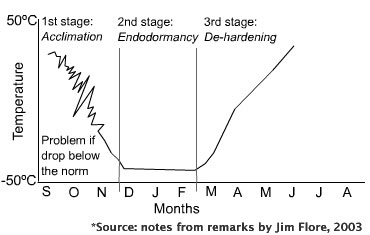Dormancy
Pileus researchers used "endodormancy," or the non-growing (resting or inactive) phase, as a starting point in the development of the tart cherry model. The three stages of "cold hardiness" occur over the fall, winter and spring months of the year, and are critical with respect to bud development, and the overall health of the tree.

1st stage: Acclimation. An important factor affecting the tree's ability to withstand cold temperatures is the degree of winter hardiness achieved during the period of acclimation. Even before the leaves fall, the tree begins to harden, which may be triggered by short days. A gradual decline in temperature, generally means an increase in hardiness. With the first killing frost, (usually in October or November), the hardiness process accelerates until about December, when it stabilizes. If the minimum or maximum temperature fluctuates outside normal range, the trees may not sufficiently acclimate in time to protect them from colder temperatures. For example in 1950, over half of the peach crop in Michigan was lost due to warm fall temperatures causing the peaches not to acclimate, and the subsequent freezing temperatures at Thanksgiving which killed many trees.
2nd stage: Endodormancy. Once the tree enters this rest period of deep winter hardiness, the tree can not be brought out of that stage until the chilling requirement has been fulfilled (a certain number of hours at temperatures between 0 and 6º C (Anderson et al., 1986). During this rest period, the vegetative and flower buds will not grow even if warmer temperatures occur. Cold temperatures during the rest period, besides causing the death of flower buds, can injure shoots, trunks, and roots, and under extreme conditions cause the death of the tree (Flore and Howell, 1987).
3rd stage: Dehardening. Once the chilling requirement has been fulfilled, the de-hardening stage is completely driven by maximum and minimum temperatures. Warm temperatures will accelerate the growth while cold temperatures will cause trees to harden again, although the plant always de-hardens faster than it hardens at this stage. This is the stage where many crops are lost due to spring freeze events. Spring freeze damage is common and the single most important weather-related risk factor for the tart cherry industry in Michigan (Flore, 1994).
(Flore, J. Communication at meeting on March 24, 2003)
NEXT TOPIC: Growing degree days (GDDs) ![]()
PREVIOUS TOPIC: Previous year's moisture![]()
LIST OF THE TOPICS IN THIS SECTION (Tart Cherry Development and Production)
- Previous year's moisture
- Dormancy (You are here)
- Growing degree days (GDDs)
- Side green
- Bloom
- Bud loss due to cold injury
- Pollination
- Relative yield